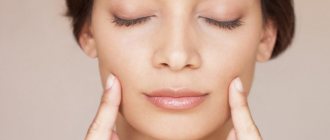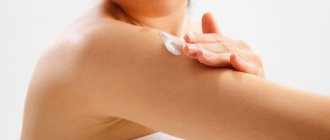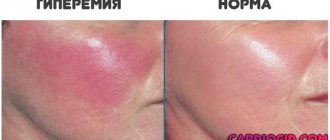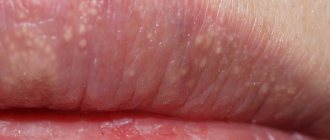The comfortable condition of the skin is inextricably linked to the degree of its hydration.
Dry skin on your hands and feet not only causes discomfort, but also leads to an increased risk of developing cracks and skin infections. The causes of dry skin are varied. The factors can be either nutritional or associated with serious chronic diseases that the person did not even know about.
Why does the skin need water?
Moisture ensures elasticity and firmness of the skin, as well as cell nutrition. The degree of hydration is determined by the condition of the stratum corneum of the skin and the amount of sebum, which are responsible for moisture exchange between the dermis and the environment. The moderate stratum corneum and fat create a lipid film on the skin, which prevents moisture from leaving the skin and aggressive environmental factors from penetrating into the skin.
The unformed protective lipid film, caused by external or internal factors, leads to excessive evaporation of moisture, which means dry skin. At the same time, microcirculation of blood and trophism deteriorates, and collagen fibers suffer. The skin becomes not only dry, but also flabby.
Why does skin dry out?
Ancient healers determined a person's health by the condition of his skin. Performing protective functions, the skin participates in water-salt metabolism and thermoregulation. Any problems with this organ indicate an incipient or progressive pathology in the body. The causes of dry skin can be both internal and external. Before stocking up on moisturizing creams, you should understand what external factor dries out the epidermis and eliminate it:
- unbalanced diet;
- bad habits;
- hair removal, depilation;
- frequent peeling sessions, dermabrasion;
- low-quality cosmetics;
- wearing synthetic underwear;
- age-related changes;
- improper care;
- low indoor humidity;
- prolonged exposure to heat or cold;
- sudden changes in temperature.
Causes of dry skin
Dry skin occurs due to a decrease in sebum production in the presence of provoking factors. Sometimes ineffective sebum secretion is a hereditary feature of the body.
- If the problem occurs in young people, it is most likely genetic.
- In mature people, this condition occurs against the background of certain external and internal reasons. Hormonal changes lead to a decrease in the activity of the sebaceous glands, which immediately affects the condition of the skin. Lack of proper care makes the problem worse.
It should be understood that in cases where dry skin is caused by internal causes (diseases or conditions of the body), no external influences - creams, baths and other procedures aimed at moisturizing and nourishing the skin do not lead to the desired effect. And only treatment of the underlying disease can improve the condition of the skin.
Internal reasons | External reasons |
|
|
Dry skin can be general or affect certain areas of the body (face, arms, legs, etc.). The localization of dryness can directly or indirectly indicate the reasons for its occurrence.
Why does the skin on my palms peel?
Peeling of the palms is much less common, but the sight is unsightly and unpleasant. The factors that lead hands to such a state are varied, and the method of solving the problem depends on the reason that caused it. If the skin on your palms is dry, you should definitely contact a dermatologist, because such symptoms appear during exacerbation of eczema, dermatitis or psoriasis. Self-medication with such a diagnosis is unacceptable. There are many diseases, signs of which are peeling and bursting of the epidermis on the palms:
- lupus erythematosus;
- staphylococcal infections;
- lichen planus;
- syphilis;
- fungal infections;
- scabies;
- hyperkeratosis, parakeratosis.
Manifestations of dry skin
There is a simple home test to help determine if you have dry skin: press your fingers on the skin until marks remain - if they do not disappear for a long time, there is a problem with dryness.
Other signs:
- Tightness. When such skin is accidentally or intentionally pulled, visible cracks appear in the stratum corneum;
- Itching. Dryness and itching of the skin accompany each other, with one phenomenon aggravating the other;
- Invisible, erased pores, as if lightly powdered;
- Irritation, redness;
- Peeling of the skin up to significant, when the skin is literally covered with scales. It becomes most noticeable after washing the skin and then drying it out.
- When complicated by an infection that has penetrated through microcracks: areas of inflammation with swelling.
Preventive measures
With good nutrition and regular moisturizing of the skin, troubles can be avoided.
Eating a diet low in fat and without excess carbohydrates not only eliminates dryness, but also prolongs the youth of the skin. Washing with water is carried out after preliminary boiling and cooling. When working with chemicals, it is important to remember to protect your skin and mucous membranes. During the cold season, the skin is wrapped as much as possible. Control of psychological state and physical training are considered factors in maintaining health. If the methods are ineffective, a visit to the doctor will help solve the skin problem.
Be sure to read:
Why do longitudinal convex stripes appear on nails?
You can also watch a video on how to care for the skin of your hands:
Treatment of dry skin and flaking
It should be understood that a qualified specialist - a dermatologist - must find out the cause and then prescribe treatment. If harmless dry skin can be dealt with without medical help, then in case of illness, creams and other products will simply be useless.
If dry skin occurs with complications in the form of irritation and microcracks, basic therapy should include ointments with dexpanthenol. Only after the irritation has been relieved can you switch to cosmetics and creams. Alcohol-containing cosmetics, aggressive peelings, and film masks should be excluded. Do not actively dry your skin with a towel after washing.
Symptoms and types
Physiological peeling occurs constantly. It is usually unnoticeable. In pathological processes it becomes more pronounced. Depending on the size of the scales, peeling can be of the following types:
| Type of peeling | Peculiarities |
| Pityriasis | The scales are very small - more like flour. Typically, a similar problem occurs with rubrophytosis (fungal disease), lichen versicolor |
| Lamellar | The scales are larger than in the previous case. This symptom is characteristic of psoriasis. The scales are loose and easy to remove |
| Large-lamellar | The tissues are torn away in large layers. This is often a sign of erythroderma (a group of skin diseases). Dead skin particles stick tightly and are quite difficult to remove. |
The scales also vary in color. If they have a silvery or whitish tint, then this is characteristic of psoriasis, yellowish - for seborrheic dermatitis, dark - for ichthyosis. In some cases (a complication of psoriasis), the keratinized particles become saturated with exudate, causing a crust to form.
During peeling, other symptoms appear:
- itching;
- redness;
- blisters that burst;
- ulcers;
- spots.
Dry hand skin
In most cases, the cause of this phenomenon is external factors. If, in addition to dryness, there are also cracks on the fingers, this may indicate hypovitaminosis, allergic contact dermatitis, fungal infections, etc. (see causes of cracks on the hands). If you have weeping cracks between your fingers, you should consult a doctor - most likely it is eczema.
General recommendations
- Protect your hands with rubber or cotton gloves when working with aggressive compounds or on the ground, washing dishes.
- Protect your hands with warm gloves or mittens in winter.
- Use pH-neutral hand and body washes.
- Use sunscreen when tanning in the sun.
- Normalize your diet, be sure to include vegetable and animal oils in the menu.
Traditional medicine recipes
- Potato mask. Peel and mash boiled potatoes in their jackets, add a spoonful of warm milk. While warm, apply the mask to the skin of your hands 2-3 times a day for 4-5 days in a row. Leave until cool.
- Olive oil and lemon juice mask. Take hand cream (1 tsp) as a base, add 1 tsp. butter and half tsp. lemon juice. Apply before bed and put on fabric gloves over it. Repeat weekly.
- Honey-glycerin compress. Mix 1 tsp. glycerin, liquid honey, flour and water and apply the mixture to your hands, wearing cloth gloves on top. It is recommended to do it a couple of times a day, every day, for 20 minutes.
- Sour cream compress. About 200 ml of sour cream with a fat content of 20% is mixed with egg yolk and lemon juice. Clean gauze is soaked in this mixture and applied to the hands, covered with cling film and a towel. After 20 minutes, wash off the residue and put cloth gloves on your hands. It is better to do it before bed for several days in a row.
- Oil bath. Heat any vegetable oil until warm and immerse the brushes in it for 20 minutes. Carry out twice a week.
Wound healing, nourishing and softening creams:
healing cream based on D-panthenol, vinylin, allatoin, vitamin E and yarrow and calendula extracts. Quickly restores the protective functions of the skin, heals cracks and regenerates the skin. Price about 85 rub. |
Healing and eliminating dryness cream. Aloe extract restores skin, accelerates regeneration, prevents cracks and softens the skin. 110 rub. |
Eliminates irritation, dryness and flaking. Ingredients: cocoa butter, D-panthenol, allatoin, glycerin and olive oil. 75 rub. |
Soothes, restores and softens the skin thanks to linden blossom and sea buckthorn extracts, sea buckthorn and wheat germ oil, glycerin, vitamin E. Price about 85 rubles. |
Eliminates dryness and flaking. Ingredients: extracts of calendula, chamomile, burdock, apricot kernel oil and Shea butter. 90 rub. |
Treatment of cracks
- Ointment made from honey and resin. In a metal saucepan, mix 10 g of oleoresin and honey, add 30 ml of vodka and 15 g of beeswax. Put on fire, stirring constantly until the mixture becomes homogeneous. Cool and refrigerate. The ointment is applied directly to the crack and sealed with a bactericidal plaster for 7-8 hours.
- Calendula ointment. Grind about 100 ml of dried plant flowers into powder and mix with 200 ml of melted pork fat. Bring until smooth in a water bath, cool. It is applied in the same way.
- Plantain ointment. Grind the dry herb into powder and add 9 parts of Vaseline and 3 drops of vegetable oil. It is applied in the same way.
Read more about the treatment of cracked hands in our article.
How to properly care for dry skin
So, we have found out the main causes of dry facial skin, now we will understand the rules of care and treatment. The main thing that needs to be done is to regularly cleanse, nourish and moisturize the skin, and also protect it from the effects of sunlight, wind and frost.
Cleansing
You should cleanse your face twice a day - in the morning and evening. For cleansing, you need to select products such as milk or cream intended for removing makeup.
It is also good to use hydrophilic oil, cleansing gel for sensitive skin.
In the morning, to cleanse dry facial skin, you can apply vegetable oil, liquid cream, or milk.
Washing with cold or hot water is very harmful. You need to make it a rule: in winter, wash your face with water at room temperature, and in summer, cool water. Before washing, you can apply fermented milk products.
Toning
After morning cleansing, the skin requires toning. A tonic lotion without alcohol is perfect for this. Apply a small amount to a cotton swab and wipe the face well, avoiding the area around the eyes.
tonic lotion, which includes natural vitamins
For toning, you can also apply creams that contain collagen and elastin. Rose water has proven itself well.
It is recommended to buy cleansing and toning products from the same manufacturer.
Cosmetologists recommend applying tonic masks two to three times a week. The toning procedure with masks should be alternated with the nutrition procedure. The right toning mask will not only tone dry skin, but also protect and tighten it.
How to moisturize your skin
Before applying makeup, moisturize your face with day cream
You need to choose a cream with a certain composition - it should contain: hyaluronic acid, milk proteins, sorbitol, antioxidants, vitamins, extracts from natural products.
After applying the product, it should be removed with a dry cloth or cotton swab after 15-20 minutes.
Skin nutrition
Before going to bed, after cleansing, the face is lubricated with a night cream that will nourish it. It should be a greasy product specially made for dry skin.
You need to choose cosmetics that contain vegetable oils, ceramides, fatty acids, aloe extracts, marine plants, whey, vitamins A, E.
Important! Night cream is applied thickly to the face one to two hours before bedtime. 10 minutes after spreading the cosmetic product, you need to blot it with a dry cloth - during this time the skin will already absorb all the nourishing ingredients
In the summer, a rich cream before bed can be replaced by wiping your face with ice cubes made from herbal decoctions.
Periodically, the skin should be nourished with masks.
Protection
The protective effect will be provided by a daytime low-fat or semi-oily cream. There are also special protective creams on sale that are designed for enhanced protection against external aggressive factors. They will need to be applied before going outside and removed after returning home.
It is especially important to protect your face with special products in winter, when it is undesirable to use moisturizers. They are applied under the powder, thus creating a thin protective film.
Dry elbows
Often occurs as a result of mechanical stress (working position with emphasis on the elbows) or infatuation with baths. Dry elbows may be a symptom of:
- hypothyroidism
- iron deficiency anemia
- diabetes mellitus
- autoimmune diseases
- skin diseases.
Traditional medicine recipes:
- Honey-coffee scrub. Add honey to the coffee grounds from a freshly brewed drink, mix and gently massage the resulting scrub onto the steamed skin of your elbows. Rinse with water and lubricate generously with vegetable oil.
- Compress of sunflower oil and sour cream - mix the ingredients in equal parts, soak clean gauze in the mixture, place it on the elbow, wrap it in a warm cloth for 20 minutes.
- Milk bath. Heat fresh milk and dip both elbows in it for 20 minutes.
Wound healing, nourishing and softening creams:
- SOS cream concentrate for very dry skin of hands and elbows from Evelyn - has an intensive effect on rough, dry skin, helps retain moisture in the skin thanks to the active complex: goat milk proteins, wheat germ oil, vitamins A, F, E, H, proelastin . Price about 70 rub.
- Ointment Radevit – eliminates peeling,
nourishes and softens the skin, actively restores the skin. Contains vitamins D2, A, E, glycerin, petroleum jelly and other components. Price about 370 rub.
What does dry skin mean?
Dry skin (xeroderma) is a symptom that the epidermis does not receive enough moisture. The epidermis is the outer layer of the skin, which is represented by horny scales. There are no living cells in the epidermis. It contains little water, about 20%. When this level of moisture decreases, the layer of skin located under the epidermis begins to evaporate it intensively. As a result, metabolism is disrupted, the skin becomes dull and vulnerable. Pathogenic microorganisms easily penetrate through such a weak layer. They can cause various diseases.
Dry facial skin
Very often this feature of facial skin is inherited. Due to the fact that the face is an open part of the body, external factors such as wind, sun, etc., provoke dry skin. Age-related skin changes and improper functioning of the sebaceous glands also aggravate the situation.
A number of pathologies of the gastrointestinal tract, central nervous system and endocrine system have dry facial skin among their symptoms. Hypovitaminosis E and A negatively affects the skin of the face.
General recommendations
- Minimize the harmful effects of environmental factors: wearing wide-brimmed hats in summer, warm wide scarves in winter.
- Use sunscreen from March to September. In winter, use creams from special “winter” series that protect the skin from wind and frost: ZIMA from Faberlic, Winter care from Biocon, Winter from Floresan.
- Wash only with neutral products, avoid bar soap.
- Regularly nourish the skin with creams designed for dry skin.
Traditional medicine recipes
- Fruit and berry mask. Crushed melon, plum and jojoba oil are mixed in equal quantities and applied to the face for a quarter of an hour. Wash off with warm water. Repeat as necessary.
- Egg-oil mask. Mix the beaten yolk of 1 egg with 1 tsp. oil (any vegetable) and carefully add 1 tsp into the mixture. pharmaceutical chamomile extract. Apply the mixture for 15 minutes, then rinse.
- Oatmeal mask. 3 tbsp. Mix oatmeal boiled in milk with 3 tbsp. olive oil, apply a thick layer to the face for 15 minutes. First wash with warm, then cool water.
Nourishing and softening creams
– provides long-term hydration and nutrition thanks to coenzyme, sesame seed oil, apricot and wheat germ oil, nanosomes and lanolin; restores skin elasticity. Price about 170 rubles. |
cosmetic product with a very high lipid content. Forms a fatty layer on the skin and protects it from drying out, without clogging pores and without the effect of a visible oily sheen. The active composition contains liquid paraffin, macrogol and cetostearyl ether. Price about 650 rub. |
contains wheat germ and aloe oil and has an intense softening and nourishing effect. Thanks to aloe, it eliminates irritation and smoothes wrinkles. Price about 65 rubles. |
Symptoms of dry skin
The following symptoms will indicate that a person has dry skin:
- Tightness of the dermis. Even with a slight impact on her, she is injured. The skin peels and flakes off.
- Ashy shade - if a person’s skin is dark, then it acquires exactly this shade. This is the main symptom of dryness.
- Cracks in the skin. They can be deep and cause pain to a person. He experiences discomfort during water procedures, during movements, etc.
- Skin itching. This symptom significantly reduces a person’s quality of life and causes severe scratching.
- Excessive dryness of the skin of the arms, legs, abdomen and back. These areas have few sebaceous glands, so the dermis there is especially dry.
- Premature skin aging. It loses its elasticity and small wrinkles appear on it. The face is primarily affected: the corners of the eyes, the nasolabial triangle, and the neck. If measures are not taken in time, the wrinkles will become deep and their number will increase.
Dry body skin
Severe dryness of the skin of the body is rarely caused by external factors, and is more often a consequence of any disease. Seasonal dryness of body skin is often associated with excessive sun tanning. People who regularly visit baths and saunas are also at risk of dry skin.
General recommendations
- Establish a drinking regime.
- Enrich your diet with dairy products, vegetable oils, fish, and nuts.
- Nourish and moisturize the skin with special creams after taking water procedures.
- Use sunscreen while tanning.
Traditional medicine recipes
- Peeling of sea salt, honey and olive oil – 4 tbsp. take 1 tbsp of honey. remaining ingredients. Lightly massage cleansed skin with the mixture, then take a shower.
- Chamomile and flax seed bath. Boil 5 tsp in 1 liter of water. flaxseed, separately boil 2 tbsp in 1 liter of water. dry chamomile - boil over low heat for 10 minutes. Strain both decoctions and add to the bath, which must be taken for 15 minutes.
- Milk and honey bath. Dissolve 200 grams of honey and 1 tsp in 1 liter of warm milk. oil (olive, almond) - add the mixture to the bath, which is taken for 15 minutes.
- Olive mask. While showering, thoroughly massage your body with heated olive oil, then rinse off the residue with warm water.
Nourishing and softening creams
Provides intense skin hydration thanks to a complex of oils and a special Cream-Oil formula. Price about 250 rubles. |
Helps retain moisture in the skin, creating a special protective layer on the skin. Hypoallergenic. Price about 130 rubles. |
Regenerating cream with panthenol, grapefruit, lime, camellia, almond oils. Eliminates dryness and tightness while maintaining the effect for 48 hours. Price about 270 rubles. |
What is the cause of dry skin of children and adults?
Nutritional factors that influence the degree of hydration of the skin of adults and children include, for example, frequent or sudden changes in ambient temperature. With prolonged exposure to cold or direct sunlight on the epithelium, or insufficient humidity in living quarters, the upper layers of the skin sharply lose moisture without having time to replenish the losses. This accelerates the peeling of the stratum corneum.
Poor-quality hygiene products, chemicals, and wearing synthetic clothing have a harmful effect on human integumentary tissue.
Sometimes dry skin on the arms and legs is only a characteristic of the genetic apparatus and a physiological indicator of an adult or child.
The constant presence of the epidermal parts in a dry state with pronounced peeling is an indicator of various diseases and disorders. These include:
- loss of body water due to digestive disorders;
- diabetes;
- vitamin deficiencies;
- liver diseases;
- keratoses;
- local hormonal therapy;
- bacterial and viral skin lesions;
- diseases of the central and peripheral parts of the nervous system;
- genitourinary diseases;
- pathology of the gallbladder and ducts.
In childhood, dry skin of the extremities can be a consequence of frequent water treatments or early termination of breastfeeding. In infants, dryness occurs due to errors in the diet of the nursing mother or incompetent use of baby hygiene products.
Be sure to read:
Why do white dots and spots appear on nails - what does this mean?
Dry heels and feet
The problem can be caused by wearing uncomfortable shoes, frequently walking barefoot, or lack of hygienic foot care. Hypovitaminosis, diseases of the endocrine system, fungal infections lead to dry feet. Dry skin on the feet if left untreated leads to the formation of areas of hardening and cracks, which can be complicated by bacterial infection (see treatment of cracked heels).
General recommendations
- Wear comfortable and proportionate shoes made of quality materials.
- Once a week, carefully remove the stratum corneum using natural pumice or scrubs.
- Use foot creams regularly.
- Make contrasting foot baths that improve skin nutrition.
- Do not walk barefoot on gravel or sand.
Traditional medicine recipes
- Apple mask. Grate a green apple on a fine grater, put the puree on gauze and apply it like this to your feet, putting them on over your socks. Leave it overnight, and in the morning wash it off and apply a suitable cream.
- Mask with castor oil. Soak gauze in warm oil, apply it to your feet and put on socks. Leave overnight, and in the morning blot off any remaining oil with a napkin.
- Oil baths. Heat the vegetable oil, pour it into a wide, flat bowl and place your feet in it. Leave for 20 minutes, then try to rub the remaining oil into the skin. Remove excess oil with wet wipes.
Nourishing and softening creams
Contains extracts of wormwood, oak, horse chestnut. Effectively softens and protects against dryness, heals small wounds, stimulates blood circulation. Price about 35 rubles. |
Reduces peeling and irritation of the skin, effectively nourishes the skin thanks to vitamins A, E, D and B5, Shostakovsky balm and extracts of eucalyptus, St. John's wort and sage. Price about 90 rubles. |
The active composition of the cream contains provitamin B5, mint oil and medicinal plant extracts. Reduces dryness and heals microcracks. Price about 40 rubles. |
Author:
Sabuk Tatyana Leonidovna hygienist, epidemiologist
If cracks appear
Problematic facial skin: treatment of pimples and blackheads
Often painful and unsightly cracks appear on the skin, which prevent a person from living normally and performing his duties.
Causes
Why does the skin on my fingers and toes crack? The cause may be a fungus that destroys the epidermis; vitamin imbalance; increased blood sugar; skin diseases; dysfunction of the endocrine system. The external environment also has a negative impact: cold or chlorinated water, household chemicals, low-quality cosmetics, temperature changes, solar radiation, tight shoes.
Treatment
Minor cracks can be treated with cosmetic creams, softening balms and herbal extracts, as well as special balms sold in pharmacies.
For deep cracks, pharmaceutical preparations are recommended: ichthyol, Vishnevsky ointment, medical glue “Sulfacrylate” and BF-6.
If the wounds are quite extensive, it is necessary to use antiseptics such as Chlorhexidine, hydrogen peroxide, Miramistin and antibacterial agents.
Among the folk remedies, a milk-glycerin solution, cedar oil, and cucumber compress are recommended.
Hand baths and masks
There are several recipes that can be prepared at home. Masks made from rye bread, boiled potatoes, honey, yolk, banana, sour cream or butter are perfect. At night, you can use “night masks” made from Vaseline. One of the best methods of moisturizing the skin is paraffin baths with cosmetic paraffin. This procedure can be carried out both in beauty salons and at home.
Another useful way to moisturize your hands is baths with herbs and berries. Most often they use pharmaceutical lingonberries (fruits, leaves), St. John's wort, horsetail, hawthorn, peppermint, frozen blackberries, blueberries, rose hips, and stone fruits.
Eliminating peeling at home
- Salt scrub. To prepare it, take a teaspoon of finely ground sea salt and mix with a tablespoon of olive oil. Apply the resulting mixture to your face, massage a little and rinse with warm water.
- Coffee peeling. Mix one tablespoon of finely ground coffee with two teaspoons of cream and apply the resulting mixture to your face. Use your fingertips to massage in a circle and rinse off the mixture with cool water.
- Banana mask. Mash a ripe banana until mushy, mix the resulting mass with one tablespoon of sour cream. Apply the mask to your face, massage the mixture into the skin, leave for ten minutes, and then rinse with warm water.
- Oatmeal scrub. Grind two tablespoons of oatmeal in a coffee grinder, mix the resulting powder with one tablespoon of kefir. Apply the mixture to your face and massage for a couple of minutes. Rinse your face and apply moisturizer.
- Cucumber peeling. Grate the cucumber on a fine grater, mix the resulting pulp with one tablespoon of potato starch. Wipe your face with the resulting mixture.
- Curd mask. Mix one tablespoon of medium-fat cottage cheese with one tablespoon of olive oil. Apply the mask for fifteen minutes.
- Mustard mask. Take one tablespoon of mustard powder and one tablespoon of olive oil, mix the ingredients and apply the mixture on your face for fifteen minutes.
- Clay scrub. Mix one tablespoon of white or green clay with one tablespoon of cream. You can add a teaspoon of salt or oat bran to the mixture.
- Egg mask. Mix one egg with a tablespoon of kefir, add a teaspoon of liquid honey to the mixture and apply the mask for ten minutes.
Please note that excessively dry skin and the appearance of flaking on it is a dermatological problem that indicates a malfunction of the body, so if skin defects do not disappear after eliminating external irritants, you need to seek help from specialists.
Take care of your health and follow our new publications. Until next time.
The use of KEEPER balm for the treatment of xerosis
When treating xerosis of the first and second degrees, the natural balm “Keeper” can provide effective assistance.
The main active component of the balm is deresined naphthalan - a unique natural substance with anti-inflammatory, analgesic, antipruritic and regenerating properties, which has been used since ancient times to treat skin diseases.
The natural essential oils included in the balm also help restore damaged skin and increase the regenerative and barrier functions of the skin.
The Guardian balm contains vitamins A and E, which accelerate regeneration and reduce inflammation. The balm does not contain hormonal or antibiotic components. Does not cause allergies or irritation.
Balm “Keeper” will help soothe damaged skin, reduce irritation and flaking, and accelerate the regeneration of affected skin areas.










